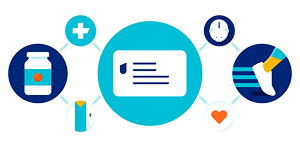Whether you’re having trouble seeing far away or up close, you have 2 main choices: glasses or contact lenses. Maybe you wear one or the other, or maybe you switch between them.
Glasses and contacts each have their pros and cons. Some people choose contacts simply because they don’t like wearing glasses. Others find that contacts are easier to wear during activities or sports. And you may even be able to see better with certain contacts.
“Contact lenses sit right on your cornea,” says Tiffany Gates, O.D., F.A.O.O., F.S.L.S. That’s the outermost “window” that covers the front part of your eye. This means that contact lenses are better for peripheral vision (seeing out of the corners of your eye) than glasses, explains Dr. Gates, an optometrist and co-owner at Visionary Eye Care in Broomfield, Colorado.
Whatever your reason for choosing contacts, here are some key things to know before getting them.
Vision insurance can help pay for contact lenses, glasses — or both. Learn how today.
Tip #1: Almost anyone can wear contacts.
If you want to wear contacts, there’s a good chance that you can do so without any problems. “The majority of people are good candidates for contact lenses,” says Dr. Gates. In fact, an estimated 45 million Americans wear contacts.
That said, there are some conditions that can make it challenging. “Dry eye, high astigmatism or patients who are timid to touch their eye may have difficulty at first,” adds Dr. Gates. (Astigmatism means that your eye has an imperfection of the curvature of its cornea or lens, which can make it harder for contacts to fit your eye.) “But these patients can find success with the right support.”
If you’re new to contacts, getting them in your eyes can be more complicated than slipping on a pair of glasses. It can take time to get the hang of it. Success depends on:
- Choosing the right kind of contacts for your eyes and your lifestyle
- Getting the right prescription
- Proper care and maintenance of your contacts
Tip #2: Your contact lens prescription is different than your glasses prescription.
You’ll need to see your eye doctor to get a prescription for contact lenses. Because contacts sit directly on your eye, the prescription will be different than the one for your glasses prescription. Your eye doctor will also measure your eyes to make sure that the lenses fit properly.
Lens prescriptions typically expire every year. You’ll likely need to see your eye doctor once a year to renew your prescription. Prescriptions can change over time, so it’s a chance to make sure that your prescription is still correcting your vision as best as it can. A yearly checkup with your eye doctor is a good idea anyway to check your overall eye health.
Tip #3: Vision insurance can help you pay for contacts.
Having coverage can help you save money on eye exams and contacts. Vision care isn’t generally covered by your health insurance plan. But you can get a supplemental vision plan (or a plan with vision and dental) to cover regular vision exams and pay for (or help you pay for) glasses and/or contacts (or sometimes both).
Vision plans typically cover new contact lenses once a year. Some plans may require a copay, or set fee, for contacts. Others may provide an allowance — say, $100. If your contacts cost more than $100, you’ll have to pay the rest out of pocket.
Vision plans can differ a lot. If you know you need contacts, look for a plan that works for your prescription. Need help finding a plan? Explore vision insurance now.
Tip #4: You have different types of contacts to choose from.
When contacts first hit the mass market, they were hard lenses made from plastic. These days, hard contacts are still an option, and they work and fit better than they used to.
But most contact wearers — about 90% — opt for soft lenses. Soft lenses are made of flexible, breathable plastics. You have a few options depending on how long they last and how long you can wear them:
- Daily wear lenses (or “dailies”) are made to be worn for a single day. You’ll start with a new pair each morning and throw them out when you remove them at night.
- Planned replacement lenses can also be worn for only a day at a time. But you can reuse them for up to 3 months. You’ll have to clean and sanitize them between wears.
- Extended-wear lenses are designed to be worn continuously for up to 30 days. If you tend to fall asleep in your contacts, these might be a good choice for you, since they’re made to be worn overnight.
If you have astigmatism or need glasses to see things up close, you’ll have other specialized lens options to choose from. Your eye doctor can help you decide which type of lens will work best for you.
Ready to explore insurance plans where you live?
Tip #5: You’ll need to care for your contacts.
Contacts have a lot of advantages, but they do come with some risks. If you don’t wear and care for your contacts the right way, they can cause eye irritation and even lead to infections. Follow these rules to keep your eyes healthy:
-
Clean your contacts every day. Wash your hands with soap and water and dry them before taking your contacts out of your eyes. Rub and rinse your contacts with contact lens disinfecting solution, then leave them to soak overnight in fresh contact solution. (Contact solution is a cleaning fluid used to disinfect and store your contact lenses.) If you use daily-wear lenses, you can skip the last part of this step.
You’ll have a hard plastic case to keep your contacts in, with spaces for your right and left lenses. Make sure to clean your case between soaks and replace it at least every 3 months.
-
Don’t wear your contacts longer than they were made to last. Most lenses are designed to be worn for a specific amount of time. Only wear lenses for as long as they are meant to be worn, whether that’s 1 day or 1 month.
-
Don’t sleep in your contacts. Wearing your contacts for a long time increases your odds of an infection. You’re up to 8 times more likely to get an eye infection if you sleep in your lenses, according to the Centers for Disease Control and Prevention (CDC). Unless you have special extended-wear lenses, you need to take your contacts out each night, before going to bed.
-
Keep your contacts away from water. Remember that contact solution? Tap or bottled water aren’t good alternatives. That’s because any type of water can have germs in it that can stick to lenses and increase your risk of infection. Water can also affect the shape of your lenses and cause them to stick to your eyes, making them uncomfortable. That’s why it’s best to take out your contacts before swimming, showering or using a hot tub.
“Overnight wear and exposure to water are leading causes of eye infections related to contact lenses,” Dr. Gates emphasizes. Despite the risks, nearly every contact lens wearer reported at least 1 behavior that could increase their risk of infection or inflammation, according to a CDC survey.
Your eye doctor can give you more guidance on how to take care of your contacts and your eyes. With proper care, contacts are a comfortable and convenient way to correct your vision.
A great place to start your contact journey is by choosing the right vision plan for your needs. Does your health insurance not include vision benefits? A standalone vision plan can be an affordable option. Explore one today, or call 1-844-211-7730 for more information.
For informational purposes only. This information is compiled by UnitedHealthcare and does not diagnose problems or recommend specific treatment. Services and medical technologies referenced herein may not be covered under your plan. Please consult directly with your primary care physician if you need medical advice.
Centers for Disease Control and Prevention. “Healthy contact lens wear and care: fast facts.” December 30, 2021. Retrieved from https://www.cdc.gov/contactlenses/fast-facts.html
Centers for Disease Control and Prevention. “Protect your eyes.” November 30, 2022. Retrieved from https://www.cdc.gov/contactlenses/protect-your-eyes.html
Centers for Disease Control and Prevention. “Water and contact lenses don’t mix.” November 30, 2022. Retrieved from https://www.cdc.gov/contactlenses/water-and-contact-lenses.html
U.S. Food and Drug Administration. “Types of contact lenses.” Retrieved from https://www.fda.gov/medical-devices/contact-lenses/types-contact-lenses Accessed March 18, 2023
Compliance code:
49812-X-0623











